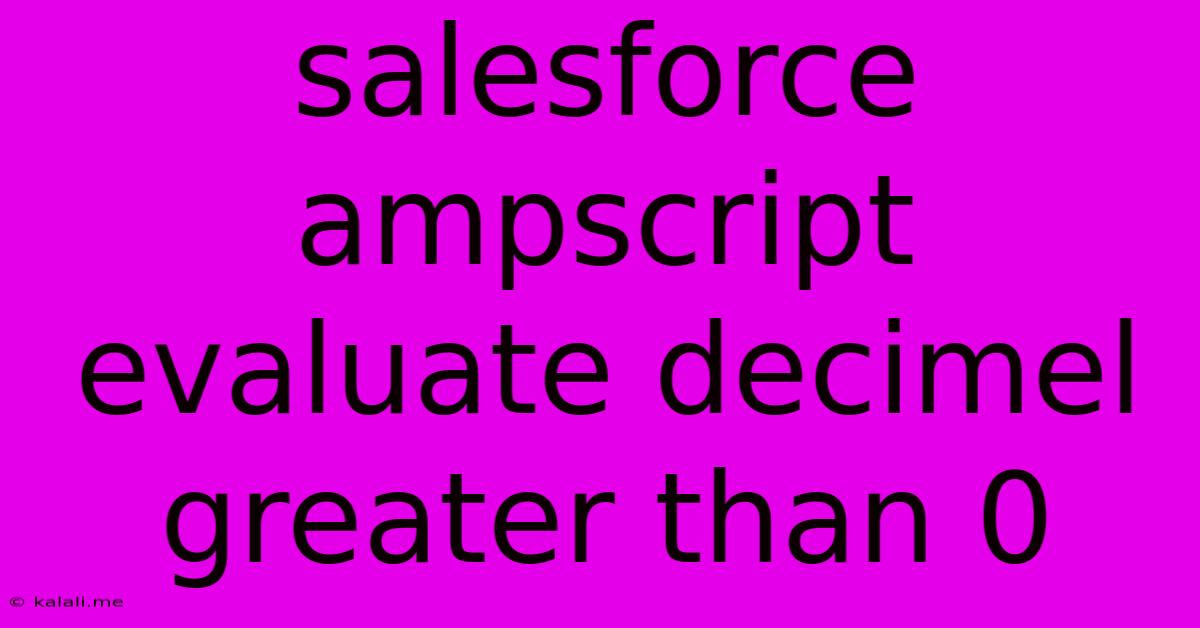Salesforce Ampscript Evaluate Decimel Greater Than 0
Kalali
May 23, 2025 · 3 min read

Table of Contents
Salesforce AMPscript: Evaluating Decimal Values Greater Than 0
This article provides a comprehensive guide on how to effectively evaluate decimal values in Salesforce AMPscript, specifically focusing on determining if a decimal is greater than zero. This is a common requirement in email marketing automation and other Salesforce applications where you need to perform conditional logic based on numerical data. We'll cover various approaches, best practices, and troubleshooting tips.
Understanding the Challenge: Directly comparing decimals in AMPscript can sometimes be tricky. While AMPscript handles decimal numbers, subtle formatting differences or unexpected data types can lead to inaccurate comparisons. This article will equip you with the tools and knowledge to avoid these pitfalls.
Method 1: Using the > Operator Directly
The most straightforward approach is to use the greater than operator (>) directly in your AMPscript code. This works reliably provided your decimal values are consistently formatted and stored as numbers.
%%[
SET @myDecimal = 0.5
IF @myDecimal > 0 THEN
SET @result = "Decimal is greater than 0"
ELSE
SET @result = "Decimal is not greater than 0"
ENDIF
]%%
Result: %%=v(@result)=%%
This code snippet demonstrates a simple comparison. If @myDecimal holds a value greater than 0, the output will be "Decimal is greater than 0"; otherwise, it will be "Decimal is not greater than 0".
Important Consideration: Ensure your @myDecimal variable accurately reflects a numerical decimal value. If it's being retrieved from a data extension, confirm the data type of the corresponding field is a number and not a text string. Improper data types can lead to incorrect comparisons.
Method 2: Handling String Conversions and Null Values
Real-world scenarios often involve data that might be stored as strings or contain null values. The following example demonstrates handling these situations robustly.
%%[
SET @myDecimalString = "1.23"
SET @myDecimal = Number(@myDecimalString)
IF @myDecimal > 0 AND @myDecimal != EMPTY THEN
SET @result = "Decimal is greater than 0"
ELSE
SET @result = "Decimal is not greater than 0 or is empty"
ENDIF
]%%
Result: %%=v(@result)=%%
This code first converts the string @myDecimalString to a number using the Number() function. The AND @myDecimal != EMPTY check safeguards against null or empty values, preventing errors. This is crucial for preventing unexpected AMPscript errors.
Method 3: Precision and Rounding
Depending on the level of precision required, consider rounding your decimal value before comparison. This is particularly relevant when dealing with calculations that might result in very small decimal values close to zero.
%%[
SET @myDecimal = 0.00001
SET @roundedDecimal = Round(@myDecimal, 4) /* Rounds to 4 decimal places */
IF @roundedDecimal > 0 THEN
SET @result = "Rounded decimal is greater than 0"
ELSE
SET @result = "Rounded decimal is not greater than 0"
ENDIF
]%%
Result: %%=v(@result)=%%
This example uses the Round() function to round @myDecimal to four decimal places before the comparison. Adjust the number of decimal places based on your specific needs.
Troubleshooting Tips
- Check Data Types: Verify that the variable you're comparing is a number and not a text string.
- Inspect Data Extension Fields: Ensure your data extension fields are correctly configured with the appropriate data types.
- Debug with Ampscript Debugger: Use the AMPscript debugger to step through your code and inspect the values of your variables at each step. This helps pinpoint the source of any unexpected behavior.
- Handle Null Values: Always account for the possibility of null or empty values to prevent errors.
By following these methods and best practices, you can confidently and accurately evaluate decimal values greater than zero in your Salesforce AMPscript code, enabling robust conditional logic in your marketing automation and other applications. Remember to always test thoroughly and consider the precision requirements of your specific use case.
Latest Posts
Latest Posts
-
How Many Days Is In 11 Weeks
Jul 14, 2025
-
How Many Grams Are In One Tola Gold
Jul 14, 2025
-
How Many Oz In A Pound Of Freon
Jul 14, 2025
-
How Many Years Are In A Millennia
Jul 14, 2025
-
Words With C As The Second Letter
Jul 14, 2025
Related Post
Thank you for visiting our website which covers about Salesforce Ampscript Evaluate Decimel Greater Than 0 . We hope the information provided has been useful to you. Feel free to contact us if you have any questions or need further assistance. See you next time and don't miss to bookmark.